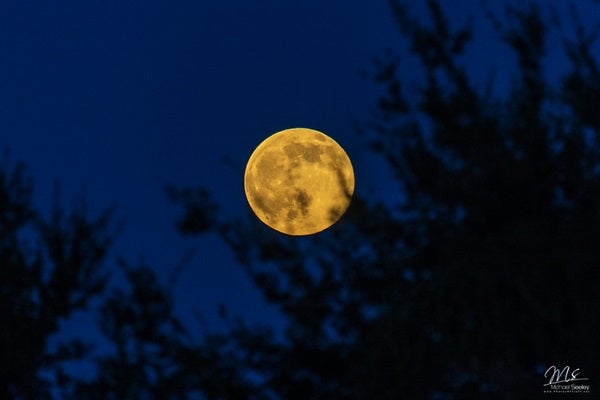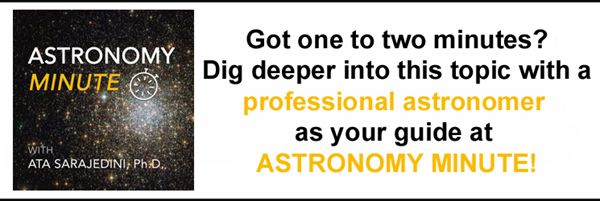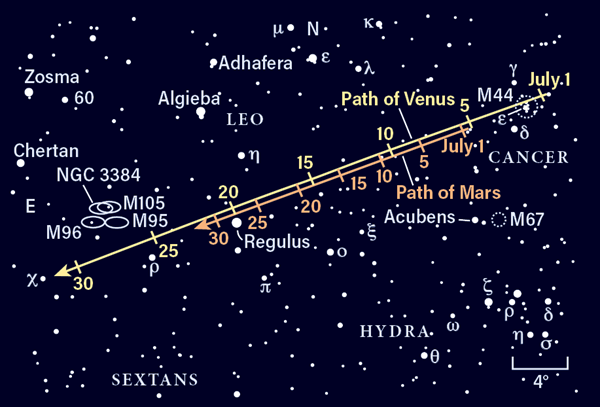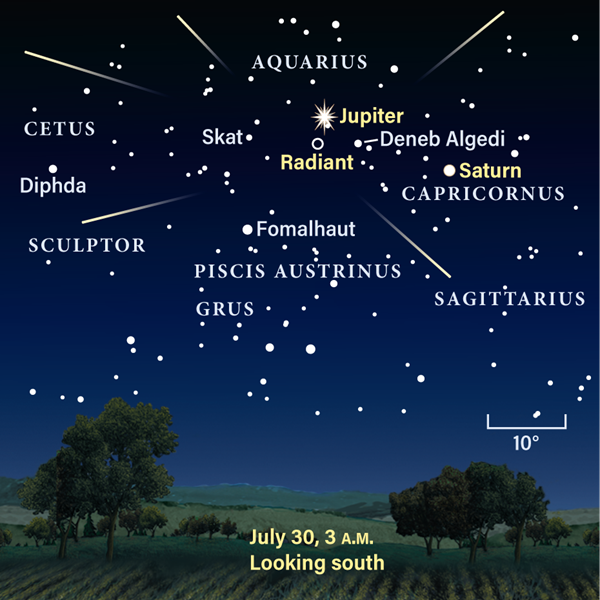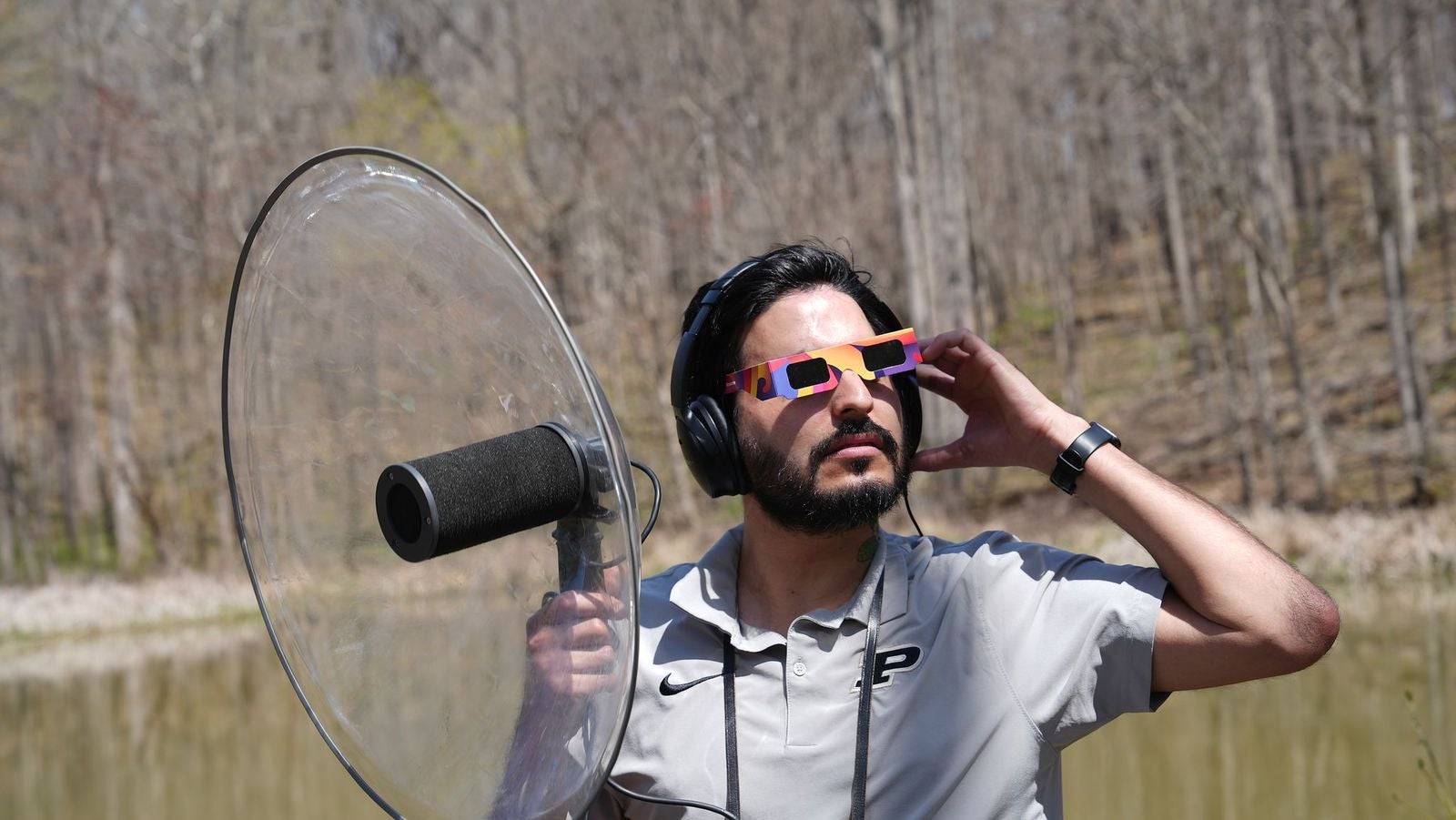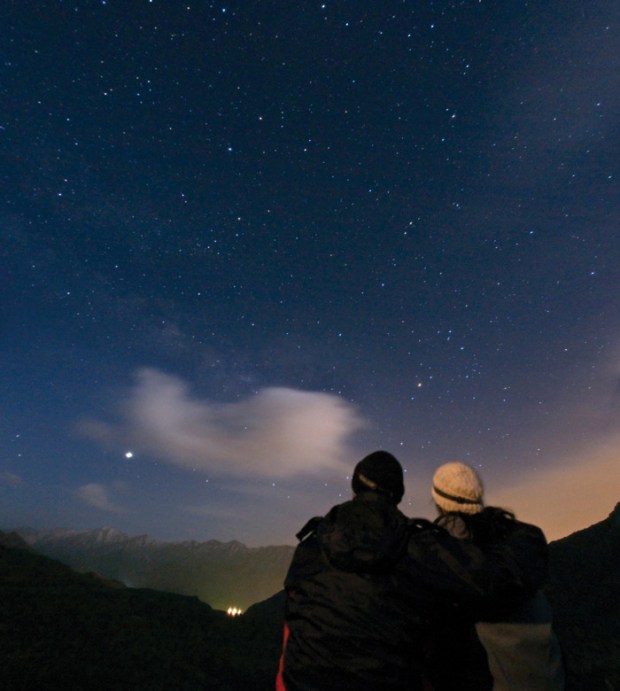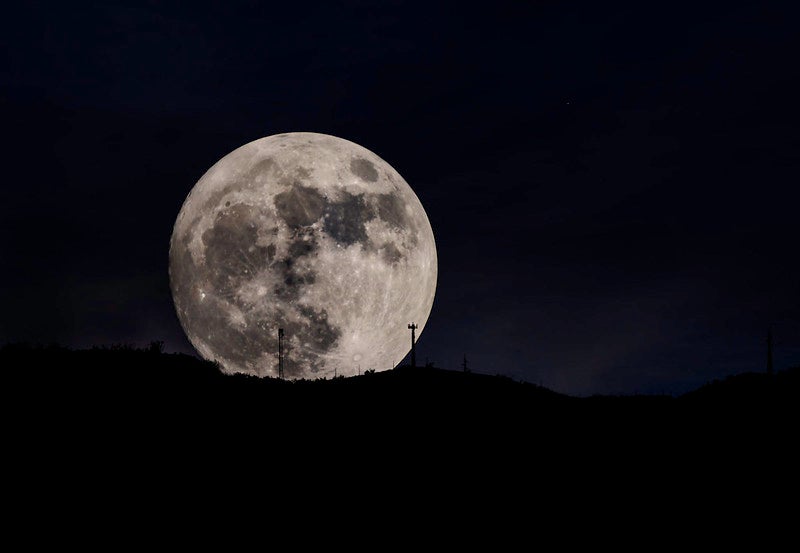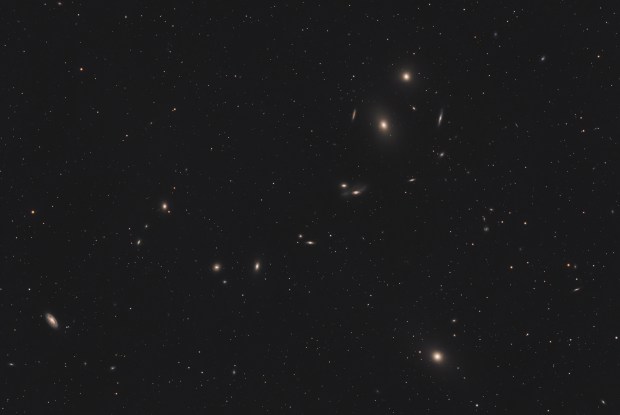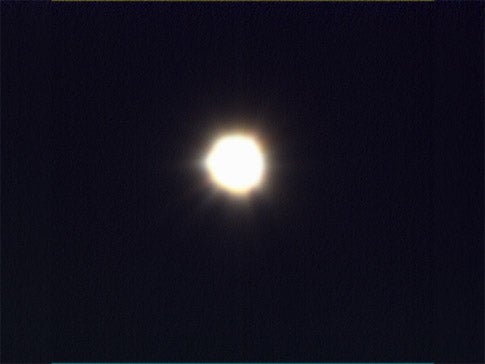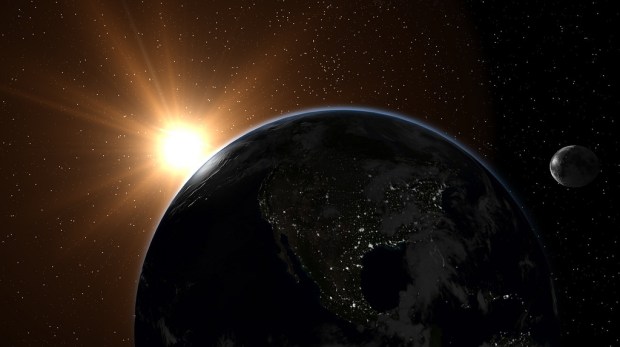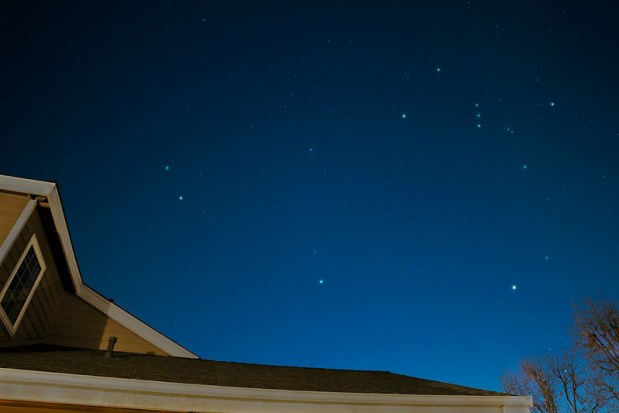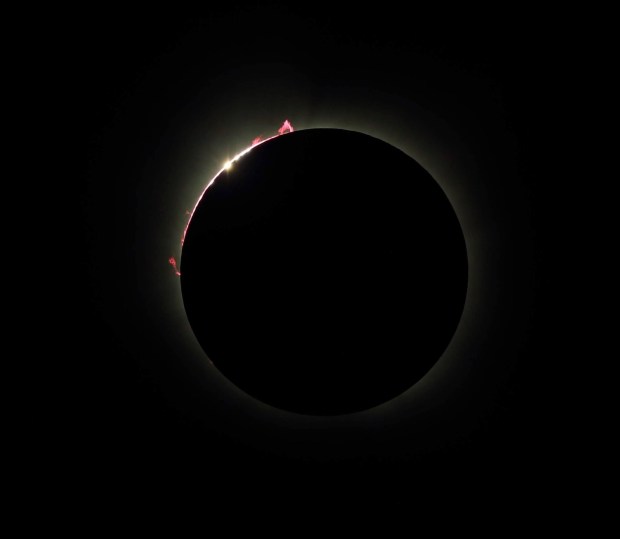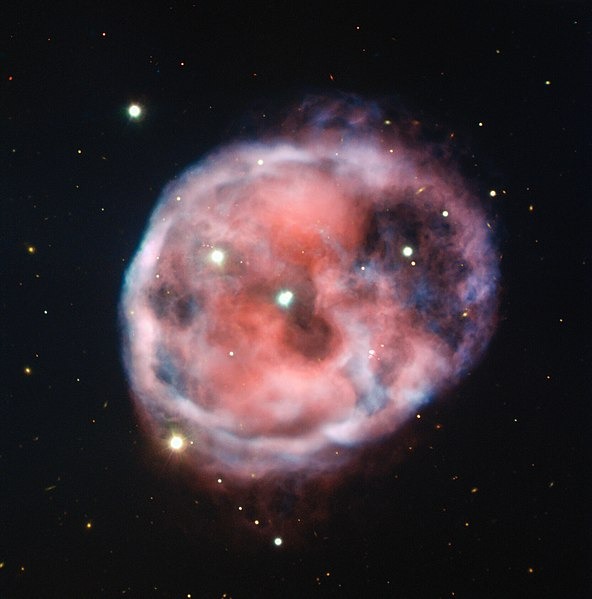Friday, July 23
Full Moon occurs at 10:37 P.M. EDT, putting the nearside of our satellite on full display. The July Full Moon is also called the Buck Moon, so named by the Native American Algonquins of the northeastern U.S. According to NASA, some may also call it the Thunder Moon, thanks to the prevalence of thunderstorms at this time of the Northern Hemisphere summer.
The Full Moon’s brightness makes it difficult to observe much else in the sky, but the Moon itself makes an excellent target, regardless of whether you have binoculars, a telescope, or no equipment at all. Naked-eye observers can easily map out the Moon’s dark seas, or maria, which are younger than the surrounding terrain and filled with ancient lava. Several of the nearside’s largest craters are also visible: Tycho in the south and Copernicus, Aristarchus, and Kepler in the lunar west (which appears east in our sky). In the lunar east, the bright spot of the Langrenus crater sits beside Mare Fecunditatis, the Sea of Fertility.
The large, rounded Sea of Tranquillity in the lunar northeast is the landing site of the famous Apollo 11 mission, the first to land men to the Moon. And Apollo 15, whose 50th launch anniversary is Monday, landed in Mare Imbrium, the larger splotch that sits west (on the Moon) of Tranquillity.
Sunrise: 5:51 A.M.
Sunset: 8:22 P.M.
Moonrise: 8:36 P.M.
Moonset: 4:56 A.M.
Moon Phase: Full
*Times for sunrise, sunset, moonrise, and moonset are given in local time from 40° N 90° W. The Moon’s illumination is given at 12 P.M. local time from the same location.
Saturday, July 24
The gibbous Moon passes 4° south of Saturn at 1 P.M. EDT. By about an hour after sunset, magnitude 0.2 Saturn is above the horizon and the Moon will rise just a few minutes later, casting its bright light across the sky. Our satellite sits about 8° southwest of Capricornus’ famous delta star, magnitude 2.9 Deneb Algedi. This star is part of an eclipsing binary system, meaning its companion star blocks it from our point of view as the pair circle each other roughly once a day. Each eclipse causes a dip of 0.2 magnitude in the star’s brightness; those with keen eyesight may notice the difference, although you’ll need to wait until the Moon is well out of the way to try for yourself.
Saturn and the Moon will continue to climb within Capricornus the Sea Goat. By 11:30 P.M. EDT, they are 7.5° apart. Even with the Moon nearby, binoculars or a telescope should reveal Saturn’s 18″-diameter disk encircled by its rings, which stretch 42″ across. Thanks to its tilt and diameter, the south polar region of the planet is currently visible.
Nearly 20° east of Saturn is Jupiter; the Moon will pass close to this planet tomorrow.
Sunrise: 5:52 A.M.
Sunset: 8:21 P.M.
Moonrise: 9:20 P.M.
Moonset: 6:07 A.M.
Moon Phase: Waning gibbous (99%)
The Moon passes 4° south of Jupiter at 9 P.M. EDT. Two hours later, the pair has cleared the horizon, with magnitude –2.8 Jupiter now nearly 4.8° northwest of the Moon. Both lie in Aquarius and will continue to rise overnight — the best time to view them.
The largest planet in the solar system, Jupiter currently sits about 380 million miles (613 million kilometers) from Earth. From that distance, its disk spans 48″. Late tonight, the four Galilean moons are arrayed around it with two on either side: Io (closer) and Callisto to the east and Europa (closer) and Ganymede to the west.
If you follow Jupiter into the early hours of July 26, you’ll see Io’s shadow cross onto the disk around 3:10 A.M. EDT, followed by the moon itself roughly 35 minutes later.
Sunrise: 5:53 A.M.
Sunset: 8:20 P.M.
Moonrise: 9:56 P.M.
Moonset: 7:20 A.M.
Moon Phase: Waning gibbous (97%)
Monday, July 26
After dark, turn your gaze just south of easy-to-recognize Cygnus the Swan, already flying high in the east. There you’ll find Vulpecula the Fox, a relatively small constellation that is home to the beautiful and often underappreciated open cluster NGC 6940.
The 0.4°-wide cluster is just over 6° southwest of magnitude 2.5 Epsilon (ϵ) Cygni. This young gaggle of suns shines around magnitude 6 and shows up well with binoculars or any small scope even under moderate light pollution, so the Moon shouldn’t interfere too badly.
While you’re in the area, make sure to stop over at Albireo, the 3rd-magnitude star that marks Cygnus’ head and beak. Although a single point of light to the naked eye, Albireo is relatively easy to split with larger binoculars or a small scope. Its components offer a stunning color contrast: one is bright blue, while the other appears deep yellow-orange. This double is one of the crown jewels of the sky’s colorful pairs, and not to be missed.
Sunrise: 5:53 A.M.
Sunset: 8:19 P.M.
Moonrise: 10:25 P.M.
Moonset: 8:30 A.M.
Moon Phase: Waning gibbous (91%)
Tuesday, July 27
Continuing its trek past the giant planets this week, the Moon passes 4° south of Neptune at 2 P.M. EDT. The best time to catch this pair, however, is in the early morning hours just after midnight on the 26th. They hang together in eastern Aquarius, with Neptune about 8° below the Circlet in Pisces.
By 4 A.M. EDT, the bright Moon lies 8.5° southwest of Neptune, which is a dim, flat, magnitude 7.7 “star” in binoculars or a telescope. Our satellite’s bright light will wash out much of the background sky, making the planet a bit harder to find. Jupiter, which sits nearly 16.5° due west of the Moon at that time and appears even with it above the horizon, will be much easier to pick out, still at magnitude –2.8.
Sunrise: 5:54 A.M.
Sunset: 8:18 P.M.
Moonrise: 10:52 P.M.
Moonset: 9:38 A.M.
Moon Phase: Waning gibbous (85%)
Wednesday, July 28
Visible above the horizon by sunset this evening is the constellation Virgo the Maiden. This month, she plays host to asteroid 4 Vesta, which tonight sits less than 1° southeast of M61, a spiral galaxy in the southern region of the massive Virgo Cluster. Vesta is two magnitudes brighter at magnitude 7.4, while M61 glows a fainter magnitude 9.7. Then again, although Vesta is a mere 326 miles (525 km) across, it lies just 240 million miles (389 million km) away. M61 is roughly 100,000 light-years across, but sits some 60 million light-years distant.
Vesta will be easy to spot with a telescope even under suburban skies, while M61 may take a bit more searching. You’ll likely be able to find the pair with binoculars from a darker site, although the Moon’s light creates natural light pollution that will up the challenge. Make sure to start searching as soon as it gets dark, as Virgo is already setting once the Sun disappears and your view will be gone shortly before midnight.
Vesta will continue southeast through Virgo, skimming close to NGC 4457 — a lenticular galaxy also in the Virgo Cluster — at the end of the month.
Sunrise: 5:55 A.M.
Sunset: 8:17 P.M.
Moonrise: 11:16 P.M.
Moonset: 10:41 A.M.
Moon Phase: Waning gibbous (77%)
Thursday, July 29
Mars passes 0.7° north of Regulus, the heart of Leo the Lion, at noon EDT. By half an hour after sunset, the pair should be visible in the west, roughly the same distance apart (although Mars has now moved just slightly northeast of the star). Magnitude 1.8 Mars is a bit fainter than the magnitude 1.4 star — can you tell the difference? As the sky grows darker, you’ll see that Mars has a distinct ruddy glow, compared with the bluer star.
About 9.5° east of the pair is bright Venus, blazing at magnitude –3.9. Although it started out the month behind (west) of Mars, it’s now pulled ahead in their race. Venus spans 13″ and appears 83 percent lit — compare this with smaller and more distant Mars, which appears only 4″ across but is virtually fully lit. You’ll have a bit more time to observe Venus, which sets just before 10 P.M. local time; Mars and Regulus will disappear below the horizon about 40 minutes earlier.
Sunrise: 5:56 A.M.
Sunset: 8:16 P.M.
Moonrise: 11:39 P.M.
Moonset: 11:43 A.M.
Moon Phase: Waning gibbous (68%)
Friday, July 30
The Southern Delta Aquariid meteor shower peaks today with a maximum observable rate of 25 meteors per hour. The best time to look for shower meteors is early in the morning, a few hours before dawn. By two hours before sunrise, the radiant — located near the 3rd-magnitude star Skat in Aquarius — is roughly 30° high in the south, just to the lower left of Jupiter. The higher the radiant climbs, the more meteors you’re likely to see — at least, until you run up against the brightening sky as dawn approaches.
Given the Moon’s presence nearby in Pisces, fainter shower members will be rendered invisible and the maximum number of meteors you’re likely to see is closer to 10 per hour. But a few bright streaks are all it takes to delight. To maximize the chances of catching a bright meteor, try to find a location with little artificial light pollution.
Although today is the peak, the Southern Delta Aquariids last through August 23, so you’ll have plenty of other mornings to seek out shower meteors once the Moon has left the sky.
Asteroid 12 Victoria, currently located in Aquila the Eagle, reaches opposition at 9 A.M. EDT. Take a break from meteor watching this morning to find the large main-belt world, named for both Queen Victoria and the Roman goddess of victory, just 2.5° east of magnitude 3 Theta (θ) Aquilae. Binoculars or a small telescope should net you Victoria’s 9th-magnitude glow.
Sunrise: 5:57 A.M.
Sunset: 8:15 P.M.
Moonrise: —
Moonset: 12:43 P.M.
Moon Phase: Waning gibbous (58%)

